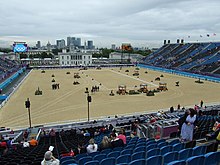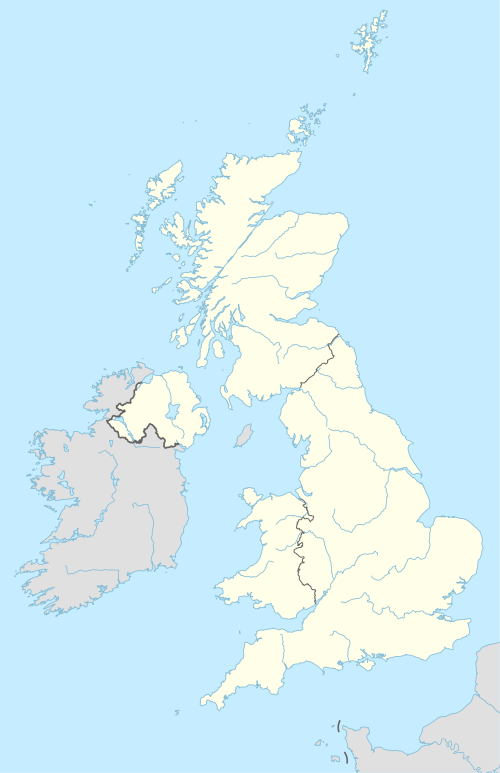Venues of the 2012 Summer Olympics and Paralympics
| Part of a series on |
| 2012 Summer Paralympics |
|---|
|
The
Sporting venues
The 2012 Games used a mixture of newly built venues, existing facilities and temporary facilities, some of them in well known locations such as Hyde Park and Horse Guards Parade. Some of the facilities are being reused in their Olympic form, while others were constructed so that they could either be reduced in size or moved elsewhere in the UK. The plans were intended to contribute to the regeneration of Stratford in east London which is the site of the Olympic Park and of the neighbouring Lower Lea Valley.
The venues within Greater London were divided into three zones: the Olympic Zone, the River Zone and the Central Zone. In addition to these were venues that, by necessity, are outside the boundaries of Greater London.
Naming
The IOC has a number of major blue-chip sponsors for the Olympics, who are entitled to have their name exclusively associated with the event. As a consequence, any other company that provided sponsorship was not permitted to use its name or branding during the games, which includes as part of the name of any venue. Thus, three Olympic venues were temporarily renamed for the duration of the Games:
- The O2 Arena – North Greenwich Arena
- Sports Direct Arena – St James' Park
- The Ricoh Arena– City of Coventry Stadium

Olympic Park Zone
The Olympic Zone encompassed all of the facilities within the 500 acres (2 km2)
| Venue | Permanent/ Temporary |
Sports | Capacity | Ref. | |
|---|---|---|---|---|---|
| Olympics | Paralympics | ||||
| Aquatics Centre | Permanent | Diving, Modern Pentathlon (swimming), Swimming, Synchronized Swimming | Swimming | 17,500 | [1][2] |
| Basketball Arena | Temporary | Basketball, Handball (medal round) | Wheelchair Rugby, Wheelchair Basketball | 12,000 | [2][3] |
BMX Track |
Permanent1 | Cycling (BMX) | — | 6,000 | [4] |
Eton Manor |
Permanent | — | Wheelchair Tennis | 10,500 | [2][5] |
Copper Box |
Permanent | Handball, Modern Pentathlon (fencing) | Goalball | 7,000 | [2][6] |
Velodrome |
Permanent1 | Cycling (track) | Cycling (track) | 6,000 | [2][7] |
| Riverbank Arena | Temporary2 | Field Hockey | Football seven-a-side, Football five-a-side | 16,000 | [2][8] |
Olympic Stadium |
Permanent | Athletics, Ceremonies (opening/closing) | Athletics, Ceremonies (opening/closing) | 80,000 | [2][9] |
| Water Polo Arena | Temporary | Water polo | — | 5,000 | [2][10] |
1: - As part of Lee Valley VeloPark
2: - Hockey facilities moved to Eton Manor
- The Olympic Village, with accommodation for all athletes and team officials (some 17,320 beds in total). After the games the village will become a district of the Stratford City development, a multibillion-pound development project on the former railway goods yard to the east of the Olympic Park. (Accredited technical officials – referees, umpires, etc. – are housed in hotel space in London Docklands).
- The Olympic Press and Broadcast Centres.
- Park Live In the heart of the Queen Elizabeth Olympic Park, Park Live was a live site accommodating over 15,000 spectators and park visitors. With two giant screens broadcasting live games coverage and a presentation stage hosting athlete and guest interviews, it was the fifth largest venue on the London 2012 Olympic Park and the first time a live site of this type had ever been created inside an Olympic Park.
The original plan called for the construction of five new indoor arenas, four in the Olympic Park, and one in the River Zone (see below). In order to save money this was reduced to two. The existing venues at Earls Court and Wembley Arena were added to the plans, and various sports were shuffled around to make this possible.
The construction of the Olympic Park itself commenced in 2006, with Murphy Group awarded the contract to remove the powerlines which crossed the site and move these into a tunnel to be dug beneath the site.
River Zone

The River Zone features four main venues in the Thames Gateway area straddling the River Thames:
| Venue | Sports | Capacity | Ref. | |
|---|---|---|---|---|
| Olympics | Paralympics | |||
| ExCeL | Boxing, Fencing, Judo, Table Tennis, Taekwondo, Weightlifting, Wrestling | Boccia, Judo, Powerlifting, Table Tennis, Volleyball (sitting), Wheelchair Fencing | from 5,000 to 10,000 | [2][12] |
| Greenwich Park | Equestrian, Modern Pentathlon (riding, running, shooting) |
Equestrian |
23,000 (OG) 6,000 (PG) |
[2][13] |
| North Greenwich Arena | Basketball (final), Gymnastics (artistic, trampolining) | Wheelchair basketball | 20,000 (OG) 18,000 (PG) |
[2][14] |
Royal Artillery Barracks |
Shooting | Archery, Shooting | 7,500 (OG) 5,000 (PG) |
[2][15] |
In the initial plan for the River Zone, a temporary 6,000 seat capacity facility to be called North Greenwich Arena 2 was to have been built alongside the O2 to host the badminton and rhythmic gymnastics events. However, the cost led to alternatives being suggested, eventually leading to the cancellation of the arena and the transfer of its planned events to Wembley Arena instead.[16]
Central Zone

The Central Zone is formed out of all the remaining venues within Greater London. They are quite widely spread across central, west and south London:
| Venue | Sports | Capacity | Ref. | |
|---|---|---|---|---|
| Olympics | Paralympics | |||
| All England Lawn Tennis and Croquet Club | Tennis | — | 30,000 | [17] |
| Earls Court Exhibition Centre | Volleyball (indoor) | — | 15,000 | [18] |
| Horse Guards Parade | Volleyball (beach) | — | 15,000 | [19] |
| Hyde Park | Swimming (marathon), Triathlon | — | 3,000 | [20] |
Lord's Cricket Ground |
Archery | — | 6,500 | [20] |
| Marathon Course | Athletics (marathon and race walk) | Athletics (marathon) | Not listed. | [21] |
| Wembley Arena | Badminton, Gymnastics (rhythmic) | — | 6,000 | [22] |
| Wembley Stadium | Football | — | 90,000 | [23] |
The men's and women's time trials in road cycling took place on specially laid out courses starting and finishing at Hampton Court Palace.[24]
Outside Greater London
Five of the venues are outside Greater London:

| Venue | Location | Sports | Capacity | Ref. | |
|---|---|---|---|---|---|
| Olympics | Paralympics | ||||
| Brands Hatch | Swanley, Kent | — | Cycling (road) | [25] | |
| Dorney Lake | Dorney, Buckinghamshire | Canoeing (sprint), Rowing | Rowing | 30,000 maximum (OG) 6,000 (PG) |
[2][26] |
| Hadleigh Farm | Hadleigh, Essex | Cycling (mountain biking) | — | 20,000 (includes 3,000 seating) | [27] |
| Lee Valley White Water Centre | Waltham Cross, Hertfordshire | Canoeing (slalom) | — | 12,000 maximum | [28] |
| Weymouth and Portland National Sailing Academy | Isle of Portland, Dorset | Sailing | Sailing | 4,600 (OG) 17,400 (PG) |
[2][29][30] |
Football stadiums
The earlier stages of the Olympic football competition were played at football stadia around the United Kingdom in addition to Wembley Stadium. Both finals (men's and women's) were held at Wembley Stadium:
| Venues | Location | Capacity | Ref. |
|---|---|---|---|
City of Coventry Stadium |
Coventry, England | 32,500 | [31] |
| Hampden Park | Glasgow, Scotland | 52,000 | [32] |
| Millennium Stadium | Cardiff, Wales | 74,600 | [33] |
| Old Trafford | Manchester, England | 76,000 | [34] |
| St James' Park | Newcastle upon Tyne, England | 52,409 | [35] |
| Wembley Stadium | London, England | 90,000 | [23] |






